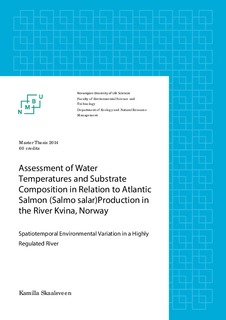| dc.description.abstract | Kvina is a heavily modified river that has faced many alterations of great magnitude caused by anthropogenic activity. Parts of the Kvina watercourse have been transferred to the Sira watercourse, contributing to the reduction in discharge from approximately 63 m³/sec to 19 m³/sec. In addition, upstream of the salmon bearing stretch the river water is stored in a reservoir, allowing the power company Sira-Kvina to regulate the river discharge through the year.
In the early 1990s the original Atlantic salmon (Salmo salar) population became extinct as a result of acidification. After initiating liming of the river the salmon repopulated the river once again. Input of sand from the Knaben molybdenum mines has also contributed to degradation of the river. The reduced discharge has caused a great quantity of fines to accumulate on the riverbed, reducing the amount of shelter and functional spawning gravel in the river.
Numerous assessments and management measures have been carried out as a means to restore the salmon population to the historical level of around 36,000 smolts, which is approximately 20,000 more than today numbers. This study was carried out in order to map some of the spatial and temporal environmental variation in Kvina throughout the summer. An assessment was carried out to investigate the functionality of the spawning areas, in terms of substrate composition and quality. Water temperature was measured in different sections of the river stretch through the summer in order to identify which weather conditions and velocities are challenge the salmon’s probability of survival.
The 2013 summer was very warm, leading to periods in July of water temperatures disadvantageous to salmon, especially during low discharge. The spatial differences became far more pronounced during July than in June or August, with large variability even within delimited parts of the river. The temperature fluctuations between day and night were in some places very large, especially in shallow areas and pools. During the warmest periods these fluctuations were of around 10-15 °C at some locations, with the highest temperature registered being 32.6 °C while the lowest was 12.1 ° C. Sections of the river of greater depth or velocity did not become as warm, potentially functioning as refuges during the warmest periods, highlighting the importance of habitat variation. There seemed to be an increasing temperature trend from north to south, which may have been a contributing factor to the observed decreased length of 0+ down the river stretch.
The substrate samples were evident of large influence of fine material in the spawning gravel, potentially reducing the oxygen supply to the eggs and promoting a selection for small eggs. There were large variations in substrate quality within each of the three stations assessed, but still a general declining trend in the downstream direction.
In this study the potential impacts of high summer temperatures and low discharge have been recognized as an important bottleneck, even though the minimum summer discharge of 3.7 m³/sec is higher than the minimum winter discharge of 1.3 m³/sec. By increasing the minimum discharge to 5-6 m³/sec in both summer and winter by installing a water bank for example, the highest peaks in temperature during the summer would most likely be reduced. In addition it may, to some extent, prevent fines from clogging and degrading habitats. Maintenance and improvement of habitat for young salmon is also essential in order to maximize smolt production. | nb_NO |
